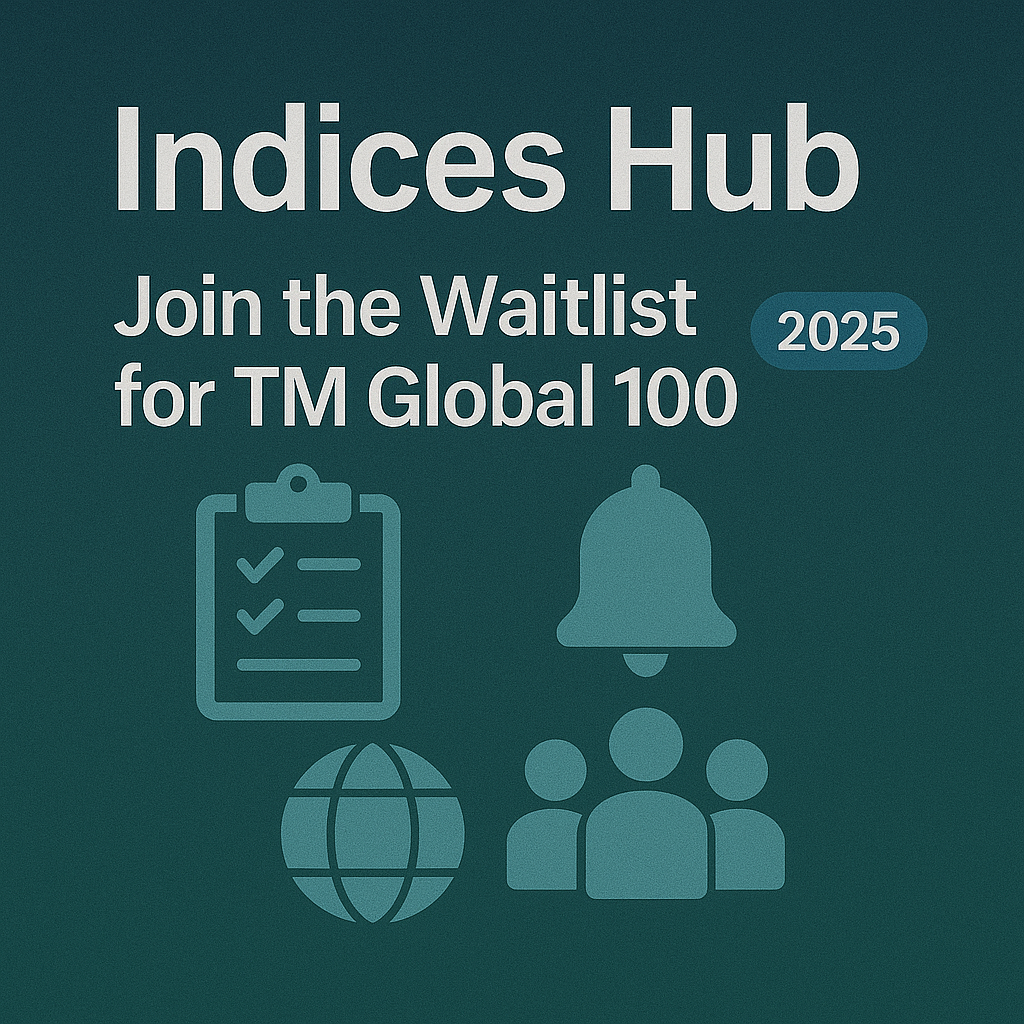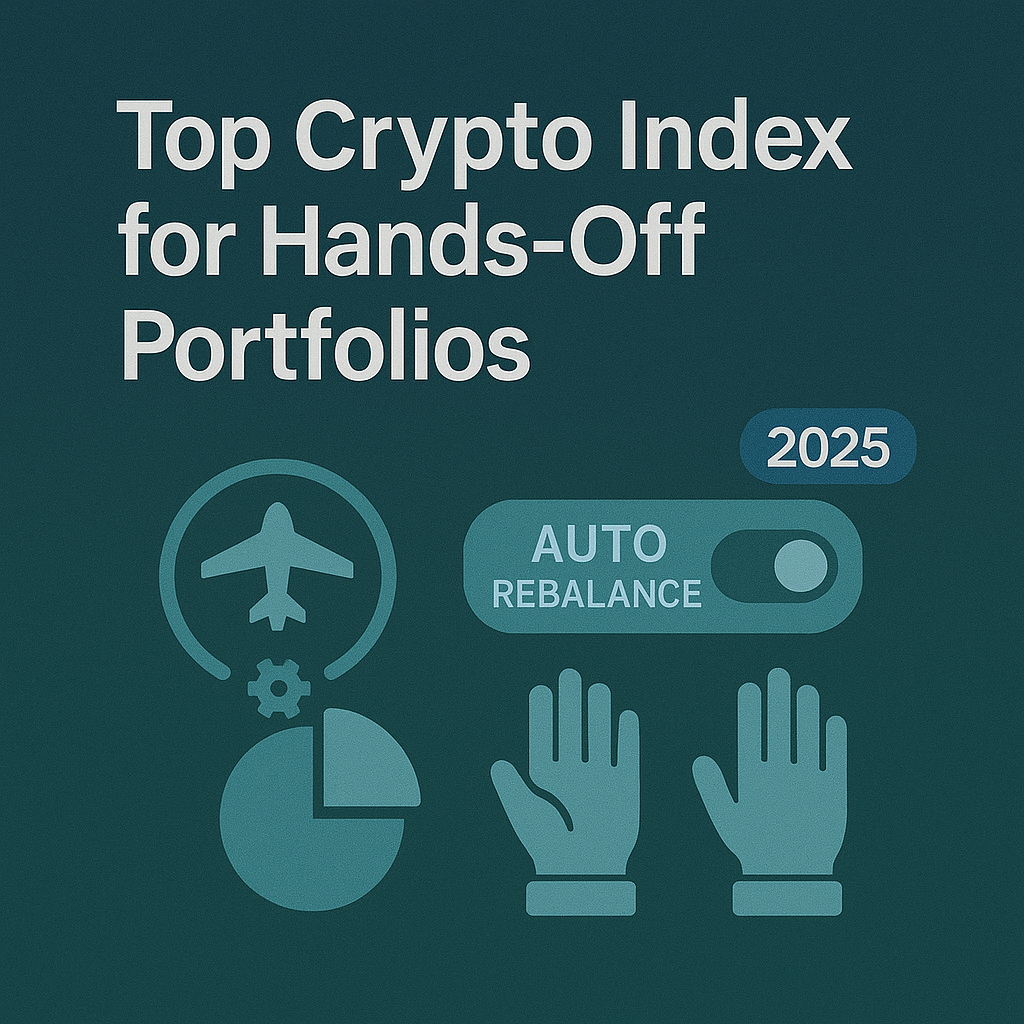Top Crypto Trading Platforms in 2025







%201.svg)
%201.svg)
Big news: We’re cranking up the heat on AI-driven crypto analytics with the launch of the Token Metrics API and our official SDK (Software Development Kit). This isn’t just an upgrade – it's a quantum leap, giving traders, hedge funds, developers, and institutions direct access to cutting-edge market intelligence, trading signals, and predictive analytics.
Crypto markets move fast, and having real-time, AI-powered insights can be the difference between catching the next big trend or getting left behind. Until now, traders and quants have been wrestling with scattered data, delayed reporting, and a lack of truly predictive analytics. Not anymore.
The Token Metrics API delivers 32+ high-performance endpoints packed with powerful AI-driven insights right into your lap, including:
Getting started with the Token Metrics API is simple:
At Token Metrics, we believe data should be decentralized, predictive, and actionable.
The Token Metrics API & SDK bring next-gen AI-powered crypto intelligence to anyone looking to trade smarter, build better, and stay ahead of the curve. With our official SDK, developers can plug these insights into their own trading bots, dashboards, and research tools – no need to reinvent the wheel.
%201.svg)
%201.svg)
If you want broad crypto exposure without babysitting charts, a top crypto index is the simplest way to participate in the market. TM Global 100 was designed for hands-off portfolios: when conditions are bullish, the index holds the top 100 crypto assets by market cap; when signals turn bearish, it moves to stablecoins and waits. You get weekly rebalancing, transparent holdings and transaction logs, and a 90-second buy flow—so you can spend less time tinkering and more time compounding your life.
→ Join the waitlist to be first to trade TM Global 100.
Volatility is back, and investors are searching for predictable, rules-based ways to capture crypto upside without micromanaging tokens. Search interest for terms like hands-off crypto investing, weekly rebalancing, and regime switching reflects the same intent: “Give me broad exposure with guardrails.”
Definition (for snippets): A crypto index is a rules-based basket of digital assets that tracks a defined universe (e.g., top-100 by market cap) with a transparent methodology and scheduled rebalancing.
For 2025’s cycle, a top crypto index helps you participate in uptrends while a regime-switching rule can step aside during drawdowns—removing guesswork and FOMO from day-to-day decisions.

Soft CTA: See the strategy and rules.


→ Join the waitlist to be first to trade TM Global 100.


What is a top crypto index?
A rules-based basket that tracks a defined universe—here, the top 100 assets by market cap—with transparent methodology and scheduled rebalancing.
How often does the index rebalance?
Weekly. Regime switches (tokens ↔ stablecoins) can also occur when the market signal changes.
What triggers the move to stablecoins?
A proprietary market-regime signal. In bearish regimes, the index exits token positions to stablecoins and waits for a bullish re-entry signal.
Can I fund with USDC or fiat?
At launch, the embedded wallet will surface supported funding/settlement options based on your chain/wallet. USDC payout is supported when selling; additional on-ramps may follow.
Is the wallet custodial?
No. It’s an embedded, self-custodial smart wallet—you control the keys.
How are fees shown?
Before confirming, the buy flow shows estimated gas, platform fee, max slippage, and minimum expected value.
How do I join the waitlist?
Visit the Token Metrics Indices hub or the TM Global 100 strategy page and tap Join Waitlist.
Crypto is volatile and can lose value. Past performance is not indicative of future results. This article is for research/education, not financial advice.
If you want hands-off, rules-based exposure to crypto’s upside—with a stablecoin backstop in bears—TM Global 100 is built for you. See the strategy, join the waitlist, and be ready to allocate on launch.
Related Reads
%201.svg)
%201.svg)
If you’ve tried to “own the market” in crypto, you’ve felt the pain: chasing listings, juggling wallets, and missing rebalances while prices move. A top 100 crypto index aims to fix that—giving you broad exposure when the market is bullish and standing down when it’s not. TM Global 100 is our rules-based version of that idea: it holds the top-100 by market cap in bull regimes, moves to stablecoins in bear regimes, and rebalances weekly. You can see every rule, every holding, and every rebalance—then buy the index in ~90 seconds with an embedded on-chain flow.
→ Join the waitlist to be first to trade TM Global 100.
The market keeps cycling. New leaders emerge quickly. A “set-and-forget” bag can fall behind, while manual baskets burn hours and rack up slippage. Search interest for crypto index, regime switching, and weekly rebalancing keeps growing because people want a simple, disciplined core that adapts.
Definition (for featured snippets): A top 100 crypto index is a rules-based basket that tracks the largest 100 crypto assets by market cap, typically rebalanced on a schedule to keep weights aligned with the market.
In 2025, that alone isn’t enough. You also need discipline for downtrends. TM Global 100 adds a regime-switching layer to move to stablecoins during bear phases—so you can participate in upside and sit out major drawdowns with a consistent, rules-based approach.
Regime switching:
Weekly rebalancing:
Transparency:
What you’ll see on launch:
Soft CTA: See the strategy and rules.


→ Join the waitlist to be first to trade TM Global 100.


What is a top 100 crypto index?
A rules-based basket tracking the largest 100 assets by market cap, typically with scheduled rebalancing. TM Global 100 adds regime switching to stablecoins during bear markets.
How often does the index rebalance?
Weekly. In addition, if the market signal flips, the entire portfolio may switch between tokens ↔ stablecoins outside the weekly cycle.
What triggers the move to stablecoins?
A proprietary market-regime signal. When it’s bearish, the index exits tokens to stablecoins and waits for a bullish re-entry signal.
Can I fund with USDC or fiat?
On launch, funding options surface based on your connected wallet and supported chains. USDC payouts are supported when selling.
Is the wallet custodial?
The embedded wallet is self-custodial—you control your funds.
How are fees shown?
Before you confirm a buy, you’ll see estimated gas, platform fee, max slippage, and minimum expected value—all up front.
How do I join the waitlist?
Go to the TM Global 100 page or the Indices hub and click Join Waitlist. You’ll get notified at launch with simple steps to buy.
Crypto is volatile and can lose value. Past performance is not indicative of future results. This article is for research/education, not financial advice.
A top 100 crypto index is the simplest path to broad market exposure—if it’s built with discipline. TM Global 100 combines transparent rules, weekly rebalancing, and a regime switch to stablecoins, so you can focus on your strategy while the core maintains itself.
Now’s the time to claim early access.
→ Join the waitlist to be first to trade TM Global 100.
Related Reads
%201.svg)
%201.svg)
After a whipsaw year, many investors are asking how to stay exposed to crypto’s upside without riding every drawdown. Rules-based crypto indexing is a simple, disciplined answer: follow a transparent set of rules rather than gut feelings. The TM Global 100 puts this into practice—own the top-100 in bullish regimes, rotate to stablecoins in bearish regimes, and rebalance weekly. On top of that, you can see what you own in real time with a Holdings Treemap, Table, and Transactions Log. Less second-guessing, more process.
→ Join the waitlist to be first to trade TM Global 100.
What it is: A rules-based index that holds the top-100 in bull markets and moves to stablecoins in bear markets—paired with transparent holdings and transaction logs.
Why it matters: Weekly rebalances and clear regime logic bring structure after volatile cycles.
Who it’s for: Hands-off allocators and active traders who want a disciplined core with visibility.
Next step: Join the waitlist to be first to trade TM Global 100.
In a volatile cycle, emotion creeps in: chasing winners late, cutting losers early, or missing re-entry after fear. Rules-based crypto indexing applies consistent criteria—constituent selection, weighting, and rebalancing—so you don’t have to improvise in stress.
For readers comparing crypto index options, think of it as a codified playbook. A rules-based crypto index is a methodology-driven basket that follows predefined signals (e.g., market regime) and maintenance schedules (e.g., weekly rebalancing), aiming for repeatable behavior across cycles.
Featured snippet definition: Rules-based crypto indexing is a systematic approach that tracks a defined universe (e.g., top-100 by market cap) and maintains it on a fixed cadence, with explicit rules for when to hold tokens and when to de-risk into stablecoins.
See the strategy and rules. (TM Global 100 strategy)


→ Join the waitlist to be first to trade TM Global 100.


What is a rules-based crypto index?
A methodology-driven basket that follows predefined rules for asset selection, weighting, and maintenance. In TM Global 100, that means top-100 exposure in bullish regimes and stablecoins in bearish regimes, with weekly rebalancing and full transparency.
How often does the index rebalance?
Weekly. This cadence refreshes constituents and weights to align with current market-cap rankings; separate regime switches can move between tokens and stablecoins.
What triggers the move to stablecoins?
A documented market signal. When it turns bearish, the index exits to stablecoins; when bullish resumes, it re-enters the top-100 basket.
Can I fund with USDC or fiat?
Funding options will surface based on your connected wallet and supported rails. USDC settlement on sells is supported; fiat on-ramps may be added over time.
Is the wallet custodial?
No. The embedded wallet is self-custodial—you control your keys and assets.
How are fees shown?
Before confirming a trade, you’ll see estimated gas, platform fee, max slippage, and min expected value—so you can proceed with clarity.
How do I join the waitlist?
Go to the Indices hub, open TM Global 100, and enter your email. You’ll receive a launch-day link to buy.
After a volatile cycle, the edge is process. TM Global 100 combines rules-based crypto indexing, weekly rebalancing, and full transparency so you can participate in upside and step aside during bears—without running your own spreadsheets. If that’s the core you’ve been missing, join the waitlist now.
Related Reads:

%201.svg)
%201.svg)
From social networks to financial services and complex blockchain platforms, Application Programming Interfaces (APIs) play a foundational yet often unseen role in the digital world. For developers, analysts, and business leaders navigating crypto and blockchain innovation, understanding APIs is critical—not just for integrating data, but for building scalable, intelligent applications.
At its core, an API (Application Programming Interface) is a set of defined rules and protocols that facilitate communication between different software programs. APIs serve as bridges, letting one application request and receive specific data or services from another—without needing to understand its internal workings. In the context of crypto, APIs are a vital backbone for everything from accessing market data in real-time to interacting with smart contracts or managing digital assets on exchanges.
Why are APIs so important? They:
For web3 and decentralized finance (DeFi), APIs are the pipes through which information and functionality flow.
Crypto APIs span a range of use-cases. Here are the most common types:
APIs are typically accessed via endpoints—URLs that represent specific requests (for example, /api/v1/prices or /api/v1/account/balance). They can use various formats, but RESTful JSON APIs dominate thanks to web-friendliness and simplicity.
APIs deliver distinct advantages but also introduce complexities—especially within the fast-evolving crypto sector.
Understanding the trade-offs between ease of access and risk is a crucial part of an effective API strategy, especially in crypto where assets and data value are significant.
APIs have revolutionized how crypto tools are built and used. Here are just a few scenarios:
Forward-thinking developers increasingly combine APIs with AI and machine learning to surface new opportunities or flag potential risks in the noisy world of digital assets.
The crypto API landscape is vast, ranging from open public endpoints to specialized commercial products. Key considerations include:
Increasingly, platforms such as Token Metrics provide unified API access to pricing, on-chain analytics, and trading signals, allowing developers and analysts to streamline their workflows and focus on higher-value research.
Build Smarter Crypto Apps & AI Agents with Token Metrics
Token Metrics provides real-time prices, trading signals, and on-chain insights all from one powerful API. Grab a Free API Key
Public APIs are open for anyone to use, often requiring just a free key or none at all. Private APIs require authentication and are used for managing user-specific actions, like placing trades or accessing sensitive account data. Both types are crucial in crypto ecosystems.
API security combines factors such as unique API keys, encrypted connections (HTTPS), and rate limiting to restrict unauthorized access. Some APIs incorporate role-based permissions or two-factor authentication for enhanced protection.
APIs may be rate-limited to protect infrastructure from abuse and ensure fair use among users. Restrictions can also be set for regulatory compliance, pricing models, or to prevent market manipulation in financial applications.
Start by selecting an API provider aligned with your needs—data, trading, analytics, etc. Follow their documentation to register an account, generate an API key, and make test requests. Most modern APIs offer free tiers for initial exploration.
Absolutely. APIs are commonly used to provide the raw data required for AI model development, and AI platforms themselves often offer APIs to serve predictions and recommendations directly into crypto applications.
This article is for informational and educational purposes only. It does not constitute investment or financial advice, and should not be construed as such. Always conduct thorough research and consult professional advisors before making decisions related to APIs, cryptocurrencies, or blockchain technology.
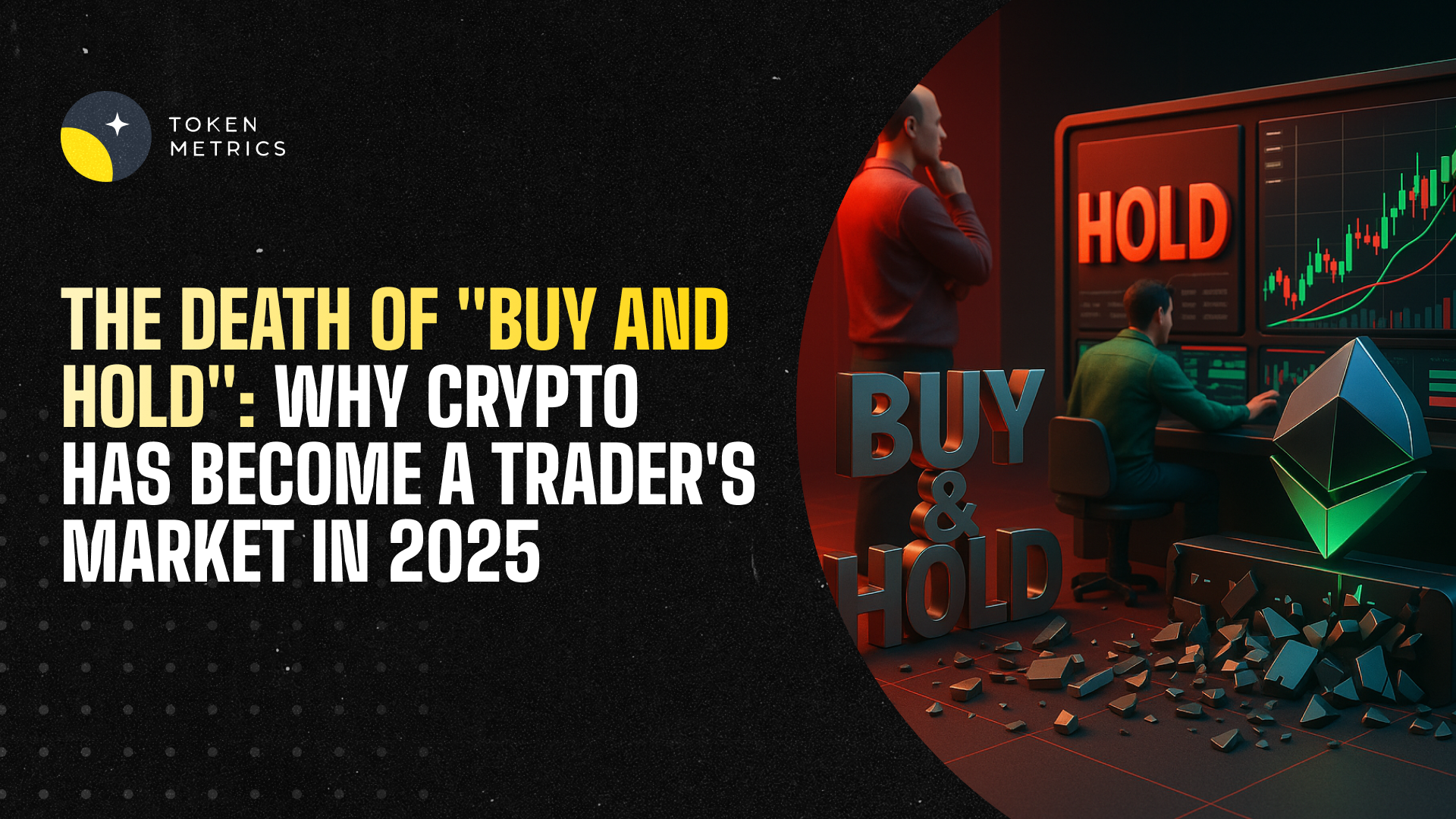
%201.svg)
%201.svg)
The cryptocurrency landscape has fundamentally shifted, and traditional investment strategies are failing investors across the board. If you're wondering why your altcoin portfolio is down 95% despite solid fundamentals, you're not alone—and there's a critical reason behind this market transformation.

According to recent market analysis from Token Metrics, we've entered what experts are calling a "trader's market." The old premise of buying based on technology and fundamentals has essentially expired this cycle. Instead, crypto has evolved into an attention economy focused on trading narratives rather than long-term value accumulation.
"The old strategy of buying and holding fundamental assets like in past cycles and expecting them to do well—that ship has sailed," explains Ian Balina, highlighting a harsh reality many investors are facing.
The core issue lies in market saturation. Today's crypto market features 100 to 1,000 times more tokens competing for the same amount of trading volume as previous cycles. This massive increase in competition has fundamentally altered market dynamics, making it nearly impossible for individual projects to maintain sustained growth through fundamentals alone.
Key factors driving this shift include:
One crucial metric investors should monitor is the Bitcoin versus Altcoin Season indicator. Currently sitting at 58%, this metric suggests that nearly 60% of returns are flowing into altcoins rather than Bitcoin.
Historically, when this indicator crosses 57%, it signals an ideal time to start trimming altcoin profits. The danger zone begins at 60% and above—previous cycle tops have seen this metric reach 80-88%, marking optimal exit points.
"This is literally a leading indicator historically on when to sell the top," notes the analysis, pointing to data from 2021 and 2022 cycle peaks.
Despite challenges in traditional crypto investing, institutional adoption continues accelerating through treasury companies. MicroStrategy leads with $70 billion in Bitcoin holdings, including $23 billion in unrealized gains. BitMine recently purchased $2.2 billion worth of Ethereum, targeting 5% of ETH's total supply.
This institutional wave extends beyond Bitcoin and Ethereum:
While most altcoins struggle, certain projects demonstrate sustainable growth models. Hyperliquid stands out as a prime example, maintaining consistent upward momentum through:
Similarly, projects with genuine utility and revenue sharing are outperforming purely speculative assets.
Interestingly, meme coins represent one segment that continues generating significant returns, albeit with extreme volatility. Projects like Bub (up 30% recently) demonstrate that community-driven assets can still achieve impressive gains, though these remain high-risk trading opportunities rather than investment plays.
Looking ahead, World Liberty Financial (WLFI) represents a significant upcoming event. Backed by the Trump family and featuring partnerships with established DeFi projects, WLFI launches September 1st with several notable characteristics:
Given these market dynamics, successful crypto participants are adapting their approaches:
The crypto market's evolution into a trader's paradise doesn't mean opportunities have disappeared—they've simply changed form. Success now requires:
The transformation of crypto from a fundamentals-driven market to an attention-based trading ecosystem represents a natural evolution as the space matures. While this shift has created challenges for traditional investors, it has also opened new opportunities for those willing to adapt their strategies.
The key lies in understanding that we're no longer in 2017 or 2021—we're in a new era where narrative, timing, and trading acumen matter more than technology assessments. Those who embrace this reality while maintaining disciplined risk management will be best positioned for success in the current market environment.
Whether you're yielding farming for steady returns, trading narratives for quick gains, or waiting for the next institutional wave, the most important step is acknowledging that the rules have changed—and your strategy should change with them.

%201.svg)
%201.svg)
The cryptocurrency market is experiencing a seismic shift as institutional adoption accelerates through treasury companies and exchange-traded funds. This institutional wave is fundamentally altering market dynamics and creating new investment opportunities for both retail and professional investors.
Treasury companies have emerged as the dominant force driving crypto adoption in 2025. These entities, which hold cryptocurrency as primary treasury assets, are experiencing unprecedented growth and creating massive buying pressure across major digital assets.

MicroStrategy continues to dominate Bitcoin treasury holdings with an impressive $70 billion worth of Bitcoin, including $23 billion in unrealized gains. The company's strategy has proven so successful that it's spawning imitators across multiple cryptocurrency ecosystems.
Recent data shows treasury companies are expanding beyond Bitcoin into Ethereum and other major cryptocurrencies, creating diversified institutional exposure to digital assets.
BitMine recently made headlines with a $2.2 billion Ethereum purchase, signaling institutional confidence in ETH's long-term prospects. The company has set an ambitious target of capturing 5% of Ethereum's total supply, demonstrating the scale of institutional appetite.
This move coincides with Ethereum hitting new all-time highs of $4,946, up 250% from April lows. The combination of treasury company purchases and growing DeFi activity has created a powerful upward momentum for ETH.
The Solana ecosystem is witnessing significant institutional interest:
B Strategy, backed by Binance founder CZ and former Bitman CFO, launched a $1 billion US-listed vehicle specifically to purchase BNB tokens. This institutional backing provides significant credibility to Binance's native token and demonstrates the expanding scope of treasury strategies.
Parallel to treasury company growth, stablecoins are experiencing explosive expansion. Total stablecoin supply now exceeds $250 billion, with projections suggesting growth to $1 trillion by next year.
MetaMask's launch of MUSD, their native stablecoin developed with Bridge (acquired by Stripe), represents a significant development. Key features include:
Current supply stands at 41 million MUSD with 5,000 holders, but this is expected to grow rapidly to billions given MetaMask's user base.
Several major developments indicate mainstream financial adoption:
Singapore's DBS Bank launched tokenized structured notes on Ethereum mainnet, though initially limited to accredited investors.
SBI Holdings from Japan, managing $74 billion, entered a joint venture with Startale to tokenize US and Japanese stocks, enabling 24/7 trading and fractional ownership.
Multiple South Korean banks are in discussions with Tether and Circle to distribute USD stablecoins, following increasing regulatory clarity.
The ETF landscape continues expanding beyond Bitcoin, creating new institutional access points:
Ethereum ETFs are seeing increased inflows as institutional interest grows. The combination of ETF buying and treasury company purchases is creating sustained upward pressure on ETH prices.

Vanna AI represents a new category of projects attracting institutional attention. Founded by Eric Voorhees (Shapeshift founder), the project offers:
The project demonstrates how utility-focused tokens can attract both institutional and retail interest through genuine product-market fit.
The Hyperliquid ecosystem is experiencing explosive growth, with several projects showing institutional-grade metrics:
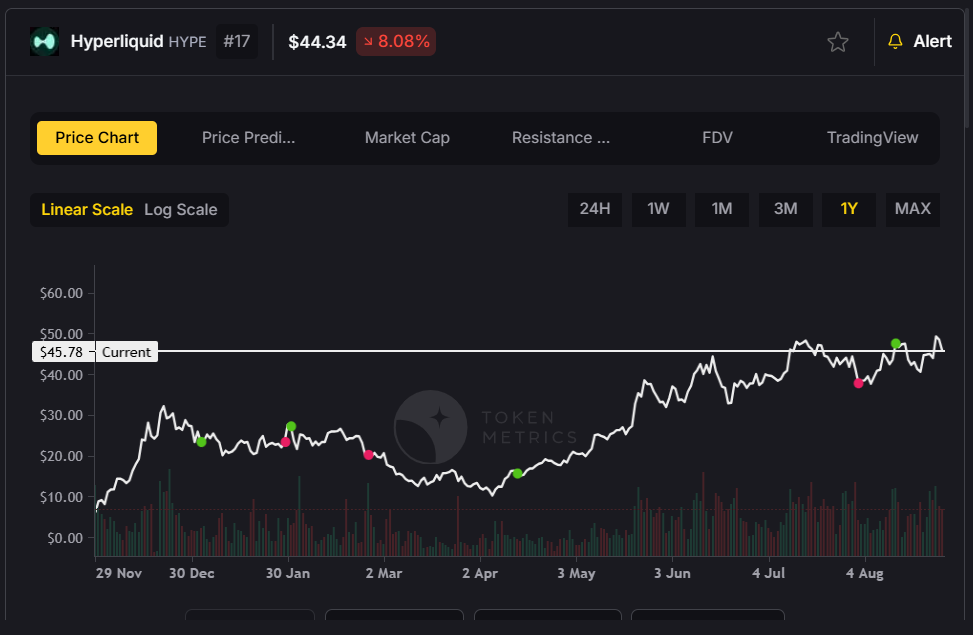
Kinetic Protocol serves as the liquid staking solution for Hyperliquid's native HYPE token, similar to Lido for Ethereum. TVL has grown from under $400 million to over $1.7 billion, demonstrating organic adoption.
Unit Protocol acts as the native bridge for Bitcoin, Ethereum, and USDC to Hyperliquid, with nearly $1 billion TVL despite no active point system.
Traditional DeFi protocols are expanding to capture multi-chain market share:
Base, Coinbase's Layer 2 solution, is emerging as a leader in consumer-focused crypto applications. The rebrand from Coinbase Wallet to Base App signals a broader strategy to become the "super app" for crypto.
Recent consumer applications include:
Given the institutional wave, experts recommend focusing on established assets:
Secondary opportunities include:
Treasury companies often trade at premiums to their underlying holdings, similar to traditional investment vehicles. Key metrics to monitor:
The altcoin season indicator currently sits at 58%, approaching the 60%+ zone that historically marks cycle tops. This suggests:
The institutional adoption wave shows no signs of slowing. Predictions suggest:
The convergence of treasury companies, ETF expansion, and consumer application growth is creating a new phase of cryptocurrency adoption. Unlike previous cycles driven by retail speculation, this institutional wave appears sustainable and growing.
Investors who understand these trends and position accordingly—whether through direct cryptocurrency exposure, treasury company stocks, or emerging ecosystem tokens—are likely to benefit from this fundamental shift in crypto market structure.
The key is recognizing that we're no longer in an early-stage speculative market, but rather witnessing the birth of a mature digital asset class with institutional backing, regulatory clarity, and real-world utility. This transformation creates both opportunities and risks that require sophisticated analysis and strategic positioning.

%201.svg)
%201.svg)
The cryptocurrency market has officially shifted into risk-off mode, marking a significant change from the bullish momentum we've witnessed over recent months. According to leading crypto analysts from Token Matrics, while the overall market indicator shows "neutral," the underlying momentum has been declining dramatically – a pattern that demands immediate attention from investors.
Bitcoin, currently trading around $114,000, has experienced what analysts describe as "momentum crashing." Despite reaching an all-time high of $124,000 just last week, the world's largest cryptocurrency has retreated below $115,000, triggering a clear sell signal on technical indicators.
This dramatic shift becomes even more apparent when examining the Bitcoin vs Altcoin Season indicator. From July 10th, when 90% of returns were concentrated in Bitcoin during its price discovery phase, the market briefly shifted to an even split between Bitcoin and altcoin returns. However, we're now witnessing a return to Bitcoin dominance – a classic sign of risk-off sentiment among crypto investors.
"I think this is just probably a healthy cooling-off correction. I don't think this is the end per se," explains Ian Belina, highlighting that while the current pullback appears significant, it may represent a necessary market reset rather than a trend reversal.

While Bitcoin struggles with declining momentum, Ethereum has emerged as the standout performer, demonstrating remarkable resilience in the current market environment. Trading around $4,300, Ethereum has surged approximately 70% since June, vastly outperforming Bitcoin's modest 9-10% gains over the same period.
The ETH/BTC ratio has climbed to 2025 highs at 0.037%, signaling a significant shift in investor preference toward Ethereum-based assets. This performance is particularly noteworthy given the regulatory clarity emerging in the United States, which has created favorable conditions for stablecoin protocols and crypto treasury adoption.
Abdullah, Head of Research & Investments at Token Matrics, remains bullish on Ethereum's prospects: "As long as ETH is above 4k, I think ETH holders shouldn't be worried. Ethereum will keep outperforming Bitcoin and Solana within the next one to three months."

Solana presents a more concerning picture, with analysts expecting a potential capitulation event that could see the token decline 30-40% from current levels. Having broken major technical support levels, Solana's momentum indicators have turned decidedly bearish.
However, this bearish outlook comes with a silver lining for long-term investors. "I think it will be a purely buy the dip opportunity before Solana starts to run again for $500 or maybe $1,000 by the end of the cycle," notes Abdullah, suggesting that current weakness may present attractive entry points for patient investors.

A major catalyst supporting the crypto market's long-term outlook is the continued accumulation by corporate treasuries. MicroStrategy recently purchased an additional 430 Bitcoin for $51 million, bringing its total holdings to approximately $7.2 billion with unrealized gains of $2.6 billion.
The trend extends beyond Bitcoin, with Ethereum treasuries gaining significant momentum. Bitcoin Immersion, led by Tom Lee, has acquired 1.52 million ETH valued at $6.6 billion, making it the second-largest public crypto treasury behind MicroStrategy and the largest for Ethereum specifically.
These institutional moves represent more than mere speculation – they signal a fundamental shift toward crypto as a legitimate treasury asset. As of now, 4% of Bitcoin's supply and 2% of Ethereum's supply is held by public companies and treasury entities.
Despite the overall bearish sentiment, several tokens continue to show strength and present compelling trading opportunities:
Chainlink has emerged as a standout performer, recently breaking through the $22-$23 resistance level that had acted as a range high for over two years. The enterprise L1 narrative is driving adoption, as Wall Street-backed firms launching their own Layer 1 blockchains require reliable oracle services.
"I think it's only a matter of time till Chainlink sees a new all-time high," predicts Abdullah, citing the protocol's dominant market position and recent tokenomics improvements, including a buyback program tied to enterprise revenue.

Despite being undervalued relative to its fundamentals, Pendle continues to show strength with a Total Value Locked (TVL) of approximately $10 billion against a market cap of only $1.4 billion. As the leading yield trading platform, Pendle offers institutional investors the ability to fix yields and trade funding rates with leverage.

Tokens within the Base ecosystem, including Aerodrome and Zora, have shown resilience despite recent corrections. With Coinbase planning to expand DEX trading access beyond the current 1% of users, these protocols could see significant volume increases.
Looking ahead, analysts expect a consolidation or correction period lasting several weeks into mid-to-late September. However, Q4 remains positioned for potential bullish momentum, particularly if the Federal Reserve delivers dovish commentary at the upcoming Jackson Hole speech.
The key for investors lies in monitoring critical indicators: the market sentiment gauge, Bitcoin vs Altcoin season metrics, and individual token momentum scores. When over 60% of market returns shift to altcoins while the overall market shows strong buy signals, it typically indicates an optimal profit-taking opportunity.
For those navigating this complex environment, focusing on tokens with strong fundamentals, high trader grades (80%+), and positive momentum indicators remains the most prudent approach. While the current market presents challenges, it also offers opportunities for those who can correctly identify and time the strongest performers in each narrative cycle.
The crypto market's evolution continues, and while short-term volatility is inevitable, the underlying infrastructure and institutional adoption trends suggest a maturing asset class with significant long-term potential.
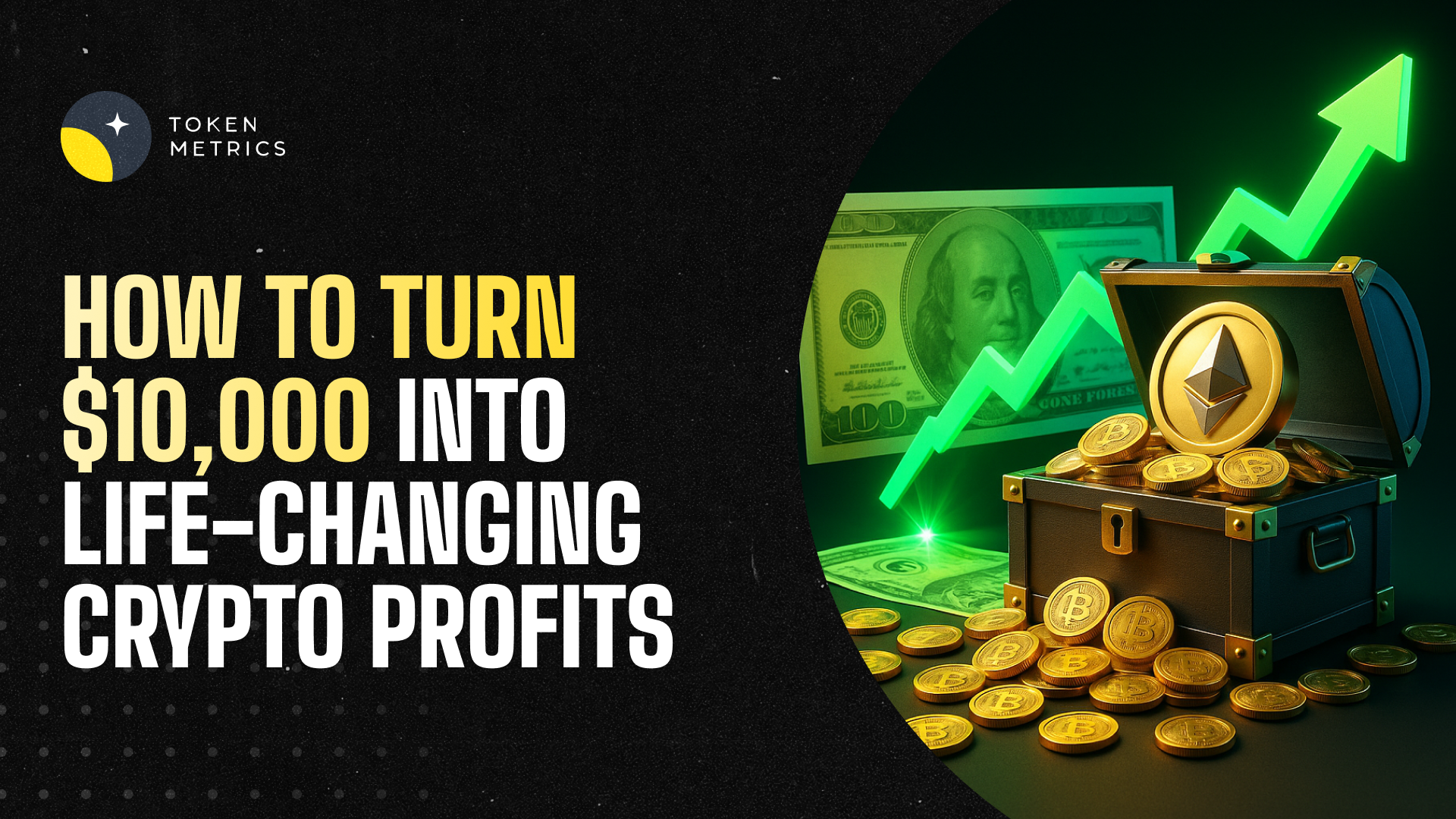
%201.svg)
%201.svg)
The cryptocurrency market has evolved dramatically, transforming from a speculative playground into a sophisticated ecosystem requiring strategic thinking and data-driven approaches. For investors looking to maximize returns with a $10,000 budget, understanding the right methodology can mean the difference between modest gains and life-changing wealth.
Successful crypto trading begins with understanding market cycles and timing. The most critical tool in any trader's arsenal is the Token Metrics market indicator – a comprehensive gauge that tells you when to be aggressive versus when to exercise caution.
When the Token Metrics market indicator shows "strong buy" with gaining momentum, it's time to operate at full throttle. Conversely, during "sell" or "strong sell" periods, conservative positioning protects capital for future opportunities. This simple principle has helped countless investors avoid the devastating losses that plague emotional traders.
"Everything starts with the market indicator. This kind of tells you how aggressive to be with your trades," explains Token Matrix's Ian Belina, emphasizing that successful trading requires adapting intensity to market conditions rather than maintaining constant aggression.
Perhaps the most overlooked yet powerful tool for profit maximization is the Bitcoin vs Altcoin Season indicator. This metric reveals when over 60% of market returns shift to altcoins – a historically reliable signal for taking profits.
Historical data shows this indicator preceded major market tops with remarkable accuracy. In December 2024, when altcoins captured nearly 60% of returns, the market peaked within days. Similarly, the January peak occurred precisely when this metric flashed warning signs.
Smart traders use this as a systematic profit-taking trigger. When altcoin returns exceed 60% while the overall market shows strong bullish signals, it's time to take 25-50% off the table, regardless of individual token performance.
Rather than scouring thousands of cryptocurrencies, successful traders focus on a curated list of trending tokens with high trader grades (80%+). This approach filters market noise and identifies where institutional money and sophisticated algorithms are placing bets.
The trending tokens methodology works because it combines:
Current examples demonstrating this strategy's power include:
Chainlink has broken through multi-year resistance at $22-$23, positioning for a potential run toward $37. The enterprise Layer 1 narrative drives this momentum as Wall Street firms launching blockchain infrastructure require robust oracle services. With improved tokenomics and a revenue-tied buyback program, Chainlink represents a "blue chip" crypto with institutional staying power.
Despite already delivering 100% returns in 30 days, Bio Protocol continues showing strength due to backing from Binance Labs and recent $1 million investment from notable crypto figure and Bitmex founder Arthur Hayes. The DeSci (Decentralized Science) narrative provides fundamental support for continued growth.
Trading at what analysts consider deeply undervalued levels, Pendle operates with $10 billion in Total Value Locked against just a $1.4 billion market cap. As institutions seek yield optimization tools, Pendle's unique position in yield tokenization and trading presents significant upside potential.
Successful crypto investors understand that markets are driven by narratives – compelling stories that capture investor imagination and drive capital flows. Current dominant narratives include:
Coinbase's gradual rollout of DEX trading functionality (currently available to just 1% of users) creates a massive catalyst for Base ecosystem tokens. Aerodrome, serving as the primary DEX aggregator, and Zora, providing social Web3 functionality, both benefit from this expanding user base.
Following the success of tokens like AIXBT (which delivered 17x returns during peak AI agent season), smart traders monitor for the next wave of AI-focused projects. However, timing remains crucial – entering established trends often leads to disappointment.
With SEC leadership changes bringing crypto-friendly policies, tokens positioned to benefit from clearer regulations command premium valuations. Stablecoin protocols and institutional DeFi platforms lead this category.
Professional crypto traders never go "all-in" on any single opportunity. The optimal approach involves:
This diversification ensures portfolio survival during inevitable corrections while maintaining upside exposure to breakout performances.
Phase 1: Market Assessment (Days 1-7)
Phase 2: Initial Deployment (Days 8-30)
Phase 3: Active Management (Ongoing)
Recent analysis suggests the current crypto cycle may extend into 2026, following historical patterns where each cycle lasts approximately 25% longer than its predecessor. This extended timeline provides multiple opportunities for strategic repositioning and compound growth.
With total crypto market cap at $4 trillion (compared to the previous cycle peak of $3 trillion), significant upside remains. Investors positioning correctly for this extended cycle could see their $10,000 investments grow substantially.

Emotional Trading: Following social media hype instead of data-driven signals leads to buying tops and selling bottoms.
Overconcentration: Putting too much capital in a single token, regardless of conviction level.
Ignoring Market Cycles: Failing to adjust strategy based on overall market conditions.
Chasing Past Performance: Buying tokens after they've already completed major moves.
The future of crypto trading lies in automation. Token Matrix and similar platforms are developing automated indices that can:
These tools democratize access to institutional-grade trading strategies, potentially transforming modest investments into significant wealth over time.
Turning $10,000 into life-changing wealth in crypto requires discipline, patience, and systematic execution. By focusing on market timing, following trending narratives, and maintaining strict risk management, investors position themselves for outsized returns while protecting against catastrophic losses.
The key lies not in finding the next 100x token, but in consistently identifying and properly timing 2-5x opportunities across multiple market cycles. With the right approach, compound growth and strategic reinvestment can transform modest beginnings into substantial wealth.
Remember: in crypto, survival is the first priority, profit is the second, and extraordinary gains come to those who master both.

%201.svg)
%201.svg)
The cryptocurrency industry is witnessing a paradigm shift as major exchanges race to build comprehensive "super apps" that consolidate trading, social features, and DeFi into single platforms. Leading this revolution is Coinbase's Base app, a ambitious project that could redefine how users interact with crypto.
The Base app represents Coinbase's vision of a crypto "everything app" – think WeChat for the blockchain era. Built on Coinbase's Layer 2 solution, Base, this platform integrates multiple crypto functions into one seamless experience:
1. Centralized & Decentralized Trading
2. Social Creator Economy
3. Mini App Ecosystem
4. Integrated Payments
Farcaster serves as the technical backbone for the Base app's social and mini-app functionality. As a decentralized social networking protocol built on Ethereum, Farcaster enables:
The Base app ecosystem presents significant opportunities for developers:
Mini App Development:
Success Stories:
Multiple major exchanges are pursuing similar strategies:
Coinbase (Base):
OKX (X Layer):
Binance (BNB Chain):
Kraken (Inc L2):
The exchange blokchain trend is driving significant value creation:
BNB Example:
Implications for Coinbase:
1. Regulatory Clarity
2. User Experience Focus
3. Ecosystem Integration
4. Developer Support
The Base app is designed to create powerful network effects:
Aerodrome (AERO):
Farcaster Ecosystem:
Zora (ZORA):
Base Ecosystem Tokens:
Scalability Concerns:
Competition Intensity:
Token Launch Uncertainty:
International Expansion:
Narrative Rotation:
The success of super apps could fundamentally change crypto:
User Behavior:
Developer Economics:
Market Structure:
Crypto super apps pose a direct threat to:
Current Status: Limited beta with waitlist Access Methods:
Preparation Steps:
Opportunity Windows:
The Base app represents more than just another crypto platform – it's a bet on the future of digital interaction. Success could establish Coinbase as the dominant force in crypto user experience, while failure could cede ground to more agile competitors.
User Adoption:
Developer Ecosystem:
Market Performance:
The Coinbase Base app represents a potentially transformative moment in crypto infrastructure. By combining social features, trading capabilities, and developer tools into a single platform, it could become the primary gateway for mainstream crypto adoption.
For investors and developers, the opportunity lies not just in the Base app itself, but in the entire ecosystem it's creating. Early positioning in Base-native projects, particularly those with lower market caps and strong integration potential, could yield significant returns as the platform scales.
However, success is far from guaranteed. The competitive landscape is intense, regulatory challenges remain, and crypto market narratives shift rapidly. The winners will be those who can execute flawlessly while adapting to changing market conditions.
The race for the crypto super app is just beginning – and the Base app has taken an early lead.
Stay ahead of crypto infrastructure trends. The platforms that win user mindshare today will shape the industry's future tomorrow.
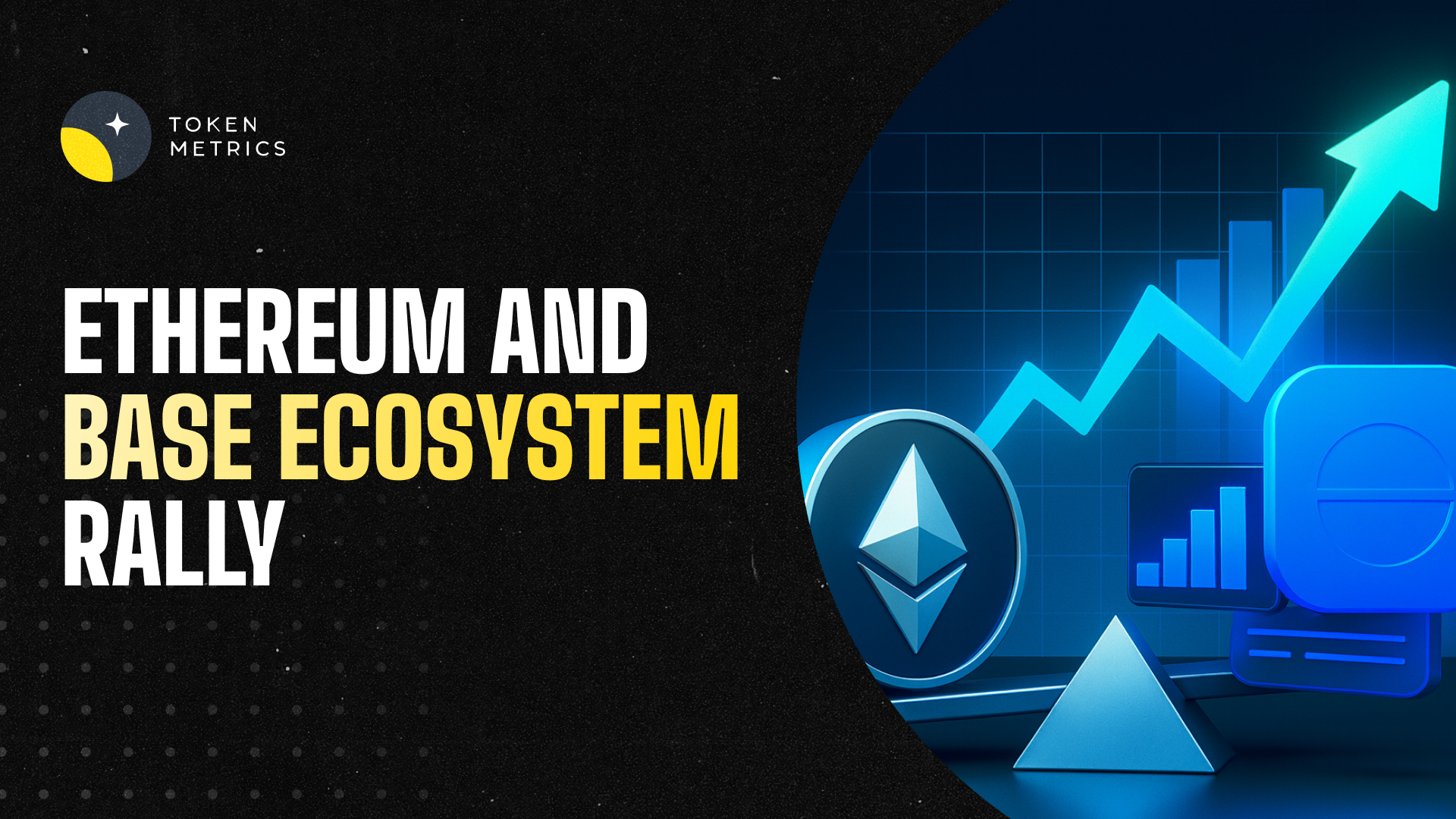
%201.svg)
%201.svg)
The cryptocurrency market is experiencing a significant narrative shift, with Ethereum and Base ecosystem projects leading the charge in early 2025. Recent market analysis reveals a concentrated rally in ETH-related tokens, presenting both opportunities and risks for crypto traders.
The crypto market has entered what experts are calling "Ethereum season," with ETH positioning itself as the number two highest-rated token in terms of trader grade. This surge isn't coincidental – it's driven by several key factors:
Major corporations are increasingly adding Ethereum to their treasury holdings, following the path Bitcoin paved. This institutional adoption has created sustained buying pressure, with Ethereum benefiting from the same "digital gold" narrative that propelled Bitcoin to new heights.
Coinbase's Layer 2 solution, Base, has become the most relevant L2 network, overtaking Arbitrum's previous dominance. The recent rebranding of Coinbase Wallet to the "Base app" has created a powerful ecosystem effect, benefiting projects deeply integrated with Base infrastructure.
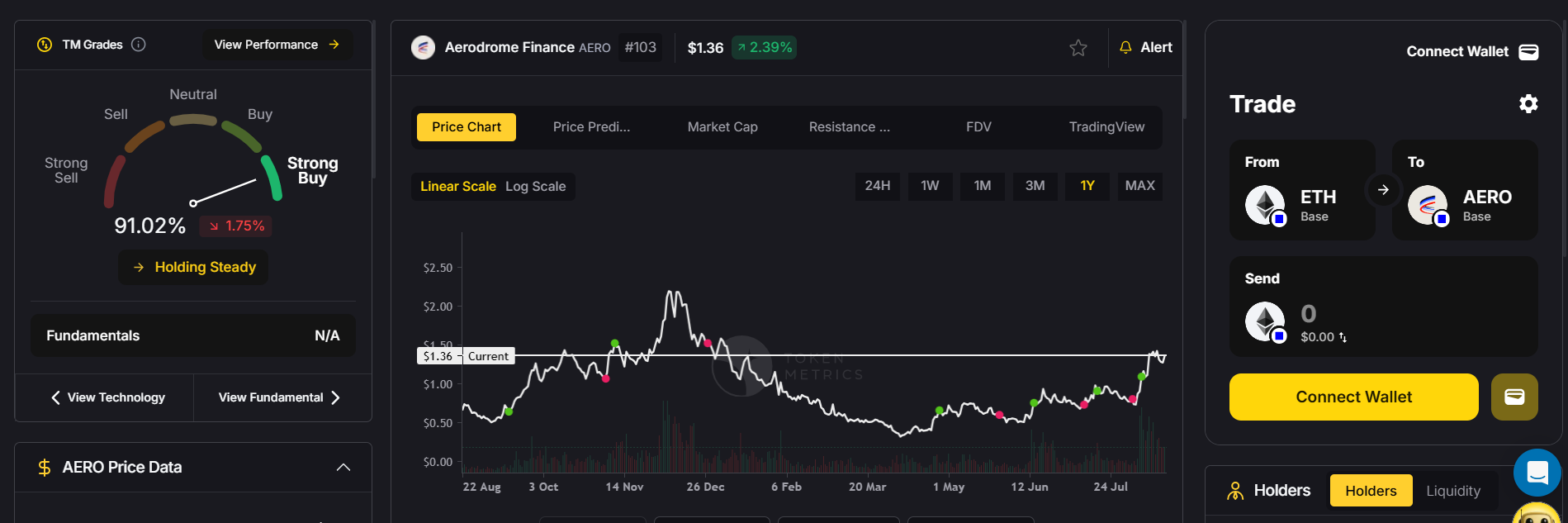
Current Market Cap: $1.2 billion
FDV: $2.3 billion
Aerodrome has emerged as the go-to liquidity solution for the Base ecosystem. With its tight integration into Coinbase's Base app ecosystem, AERO has significant upside potential as the Base app remains in limited beta. Once full access opens to Coinbase's broader user base, liquidity demand could skyrocket.
Key Advantages:

Current Market Cap: Under $1 billion
FDV: $1.6 billion
Pendle is positioning itself as essential DeFi infrastructure, often compared to the "new Aave." The project has attracted significant institutional investment and offers unique yield trading mechanisms that differentiate it from traditional lending protocols.
Growth Drivers:

Current Market Cap: $2.3 billion
FDV: $11.6 billion
Ethena has created a revolutionary synthetic stablecoin (USDe) that generates yield through delta-neutral trading strategies. The protocol has achieved remarkable growth, reaching 10 billion in stablecoin supply faster than both USDC and Tether historically.
Unique Features:
The current market requires a narrative-focused trading strategy rather than pure fundamental analysis. Here's why:
The crypto market has become increasingly trader-oriented, with attention shifting between sectors rapidly. Projects with strong fundamentals can underperform if they're not part of the current narrative cycle.
Previous cycles show clear rotation patterns:
Smart traders are:
Coinbase's strategic moves are creating a "super app" ecosystem similar to WeChat but built on crypto rails:
Other exchanges are following suit:
History shows that even blue-chip projects can decline 85-90% when narratives shift. AI tokens like AXBT fell from $0.80 to $0.13 despite strong fundamentals.
The Ethereum/Base narrative may be reaching maturity. Smart money is:
Successful traders are implementing:
Smart traders are already positioning for potential rotations into:
The Ethereum and Base ecosystem rally presents compelling short-term opportunities, but requires disciplined execution and risk management. Focus on projects with strong narrative alignment, lower valuations relative to peers, and clear catalysts for continued growth.
Remember: in the current market environment, being right about fundamentals isn't enough – you need to be right about narrative timing. Stay flexible, use alerts effectively, and be prepared to rotate when the market's attention shifts.
The crypto market moves fast. Stay informed with real-time analysis and trading signals to maximize your opportunities while managing risk effectively.

%201.svg)
%201.svg)
As crypto trading automation accelerates into 2025, choosing the right API interface for your bot could be the critical difference between lagging behind or capitalizing on real-time opportunities. But when it comes to REST vs WebSocket crypto APIs, which technology should you select for power, reliability, and performance? This post details the core differences, essential trade-offs, and latest best practices for crypto API comparison, empowering you to make a technical, mission-aligned decision for your next-generation trading bot.
To understand which API protocol is optimal for your crypto bot in 2025, let’s clarify what REST and WebSocket actually do—especially in a high-frequency, automation-driven ecosystem.
The fundamental contrast: REST works in a "pull" model (request/response), while WebSockets operate in a "push" paradigm (real-time streams). This distinction plays a major role in how bots interact with exchanges and handle crypto market shifts.
Performance and data freshness are critical for crypto APIs in 2025. High-frequency or latency-sensitive trading bots depend on receiving accurate, instant data on price movements and order book changes.
Yet reliability considerations persist. WebSocket connections may experience drops, require reconnection logic, and occasionally miss events during high network volatility. REST, while slower, may provide more consistency under unstable conditions.
Your crypto bot’s requirements—frequency of updates, types of orders, and compliance frameworks—may drive the API choice. Here’s how REST and WebSocket compare across scenarios relevant in 2025:
Security-wise, REST can offer granular access controls per endpoint. WebSockets, though encrypted, have unique session management and timeout considerations—especially important for bots managing real funds.
In the ever-evolving crypto automation landscape, developers and researchers are seeing:
Ultimately, the “better” API depends on your bot’s profile: Speed-critical, event-driven bots gravitate to WebSockets, while research bots or those trading on daily signals may remain with REST. Many leading bot frameworks in 2025 offer seamless switching or even run hybrid workflows for best-in-class resilience.
When evaluating crypto APIs for your bot or automation project, consider these practical criteria:
Above all, test API performance in real-market scenarios—using sandboxes or historical replays—to ensure your bot’s architecture is future-proofed for 2025 volatility and growth.
Build Smarter Crypto Apps & AI Agents with Token Metrics
Token Metrics provides real-time prices, trading signals, and on-chain insights all from one powerful API. Grab a Free API Key
REST APIs use isolated request/response cycles and are suited for infrequent or simple queries. WebSocket APIs sustain continuous, two-way connections for real-time market data updates. The choice depends on whether your bot needs static or streaming data.
WebSocket APIs are preferred for real-time trading bots due to their lower latency and ability to push instant data updates. However, implementation complexity and stability must be considered.
Yes. Many bots use REST for account management or trade execution and WebSocket for live data streams. This hybrid approach leverages the strengths of each protocol.
Both protocols utilize SSL encryption and API key-based authentication, but WebSocket sessions require more careful management and regular re-authentication to prevent stale or hijacked connections.
Assess your bot’s use case—speed versus reliability, frequency of queries, data intensity, and integration requirements. Testing both protocols with your trading logic is recommended for optimization.
This content is for educational and informational purposes only. It does not constitute investment, trading, or financial advice. Past performance and API platform capabilities are not guarantees of future results. Always perform independent research and technical due diligence before building or deploying trading bots or utilizing API-based automation tools.

%201.svg)
%201.svg)
Coding your first crypto trading bot can be an exciting journey into algorithmic trading, automation, and the world of digital assets. But for many beginners, the path is full of unexpected hurdles. Rushing into bot development without understanding key risks can lead to costly errors, technical failures, and frustration. In this article, we break down the top mistakes to avoid when building your first crypto trading bot, and offer actionable insights so you can start your automation journey on solid ground.
Many new developers are eager to start building a crypto trading bot after seeing success stories or reading about impressive returns from algorithmic strategies. However, skipping foundational learning can result in critical errors:
Before you start coding, invest time to learn how exchanges work, typical trading strategies, and the programming language you intend to use (often Python or JavaScript for most bot frameworks). Familiarize yourself with basic quantitative analysis and backtesting tools to ground your bot in solid logic.
One of the most widespread beginner crypto bot mistakes is failing to build robust risk controls into the automated system. While automation can remove human error and emotion, it cannot protect you from strategy-flaws or market anomalies by default. Major risks include:
Consider embedding risk-limiting features. For example, restrict order sizes to a fraction of your total balance and always code for the possibility of missed, delayed, or partially filled orders.
APIs are the backbone of any crypto trading bot, allowing programmatic access to price data, balances, and order actions. For beginners, choosing subpar or poorly documented APIs is a frequent pitfall. Key issues include:
Take time to evaluate API documentation, community support, and reliability. Explore well-maintained libraries and modules, and always use environment variables or secure vaults for your credentials.
It's tempting to deploy your trading bot live the moment it compiles without error. However, skipping backtesting—testing your bot on historical data—or forward-testing on a demo account is a recipe for unexpected behavior. Top mistakes here include:
Carefully test your strategies with a range of market conditions and environments before risking live funds. Look for open-source backtesting libraries and consider using paper trading features offered by many exchanges.
Crypto trading bots operate with sensitive account access and sometimes large balances at risk. New developers often underestimate the importance of security and regulatory compliance. Watch out for:
Implement best practices for code security and stay attentive to legal developments in your jurisdiction. Avoid shortcuts that could put your assets or reputation in danger.
Build Smarter Crypto Apps & AI Agents with Token Metrics
Token Metrics provides real-time prices, trading signals, and on-chain insights all from one powerful API. Grab a Free API Key
Most crypto trading bots are built in Python or JavaScript due to strong libraries and exchange support. Some advanced users deploy bots in Java, C#, or Go for higher performance, but Python is considered beginner-friendly.
Start with backtesting using historical data, then use exchange-provided sandboxes or paper trading environments. This lets you observe your bot’s actual behavior without risking real money or assets.
Store API keys in environment variables or encrypted vaults, restrict key permissions, and never share or publish them. Rotate keys periodically and monitor logs for unauthorized activity.
Yes; even well-tested bots can lose money due to market changes, exchange outages, slippage, or unforeseen bugs. Continuous monitoring and updates are essential for risk control.
Platforms offering real-time market data, robust APIs, and community support can help. AI-powered research tools like Token Metrics can assist with backtesting and market analysis, while open-source frameworks provide learning resources.
This article is for educational purposes only and should not be construed as investment, financial, or trading advice. Crypto trading bots carry risks, and readers should conduct thorough research and consult with professionals as appropriate. Always follow relevant laws and exchange terms of service.


 Create Your Free Account
Create Your Free Account9450 SW Gemini Dr
PMB 59348
Beaverton, Oregon 97008-7105 US
.svg)




.png)
Token Metrics Media LLC is a regular publication of information, analysis, and commentary focused especially on blockchain technology and business, cryptocurrency, blockchain-based tokens, market trends, and trading strategies.
Token Metrics Media LLC does not provide individually tailored investment advice and does not take a subscriber’s or anyone’s personal circumstances into consideration when discussing investments; nor is Token Metrics Advisers LLC registered as an investment adviser or broker-dealer in any jurisdiction.
Information contained herein is not an offer or solicitation to buy, hold, or sell any security. The Token Metrics team has advised and invested in many blockchain companies. A complete list of their advisory roles and current holdings can be viewed here: https://tokenmetrics.com/disclosures.html/
Token Metrics Media LLC relies on information from various sources believed to be reliable, including clients and third parties, but cannot guarantee the accuracy and completeness of that information. Additionally, Token Metrics Media LLC does not provide tax advice, and investors are encouraged to consult with their personal tax advisors.
All investing involves risk, including the possible loss of money you invest, and past performance does not guarantee future performance. Ratings and price predictions are provided for informational and illustrative purposes, and may not reflect actual future performance.

